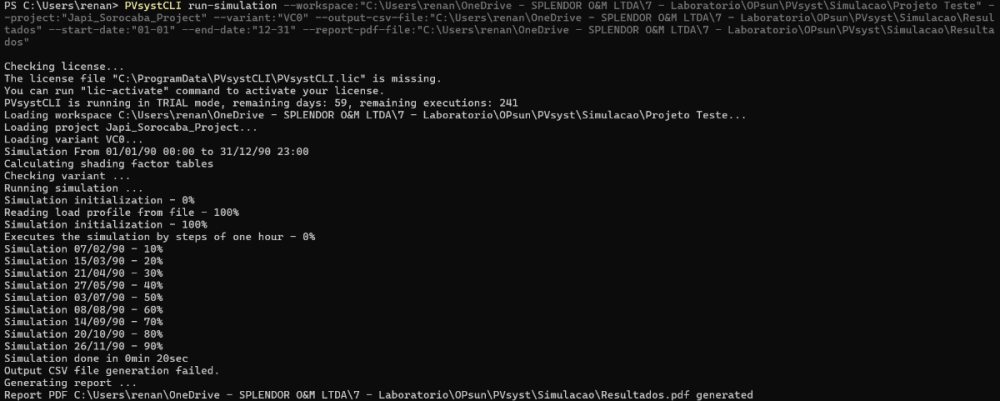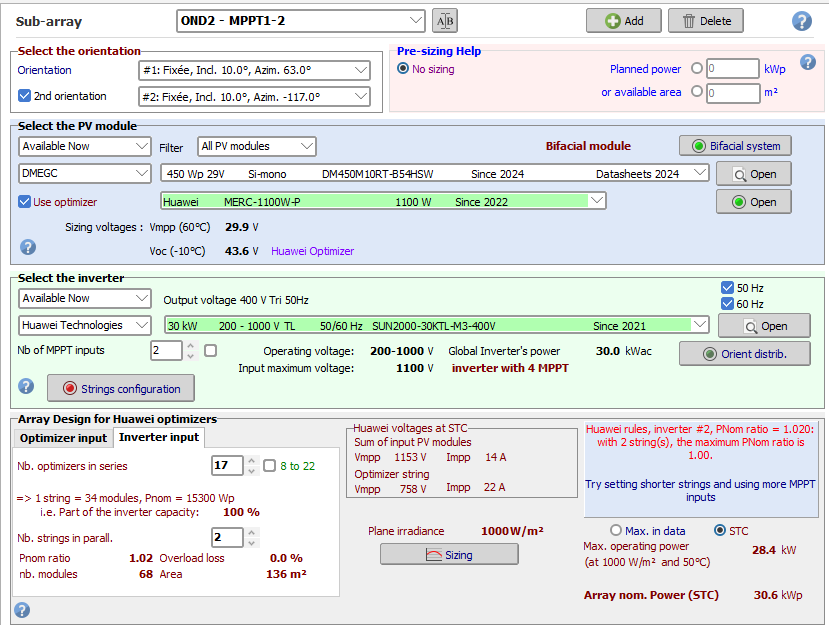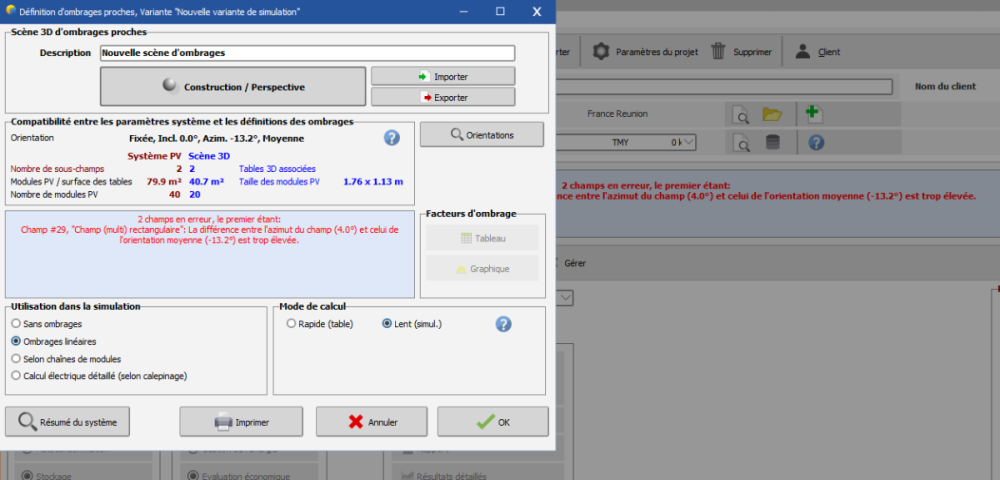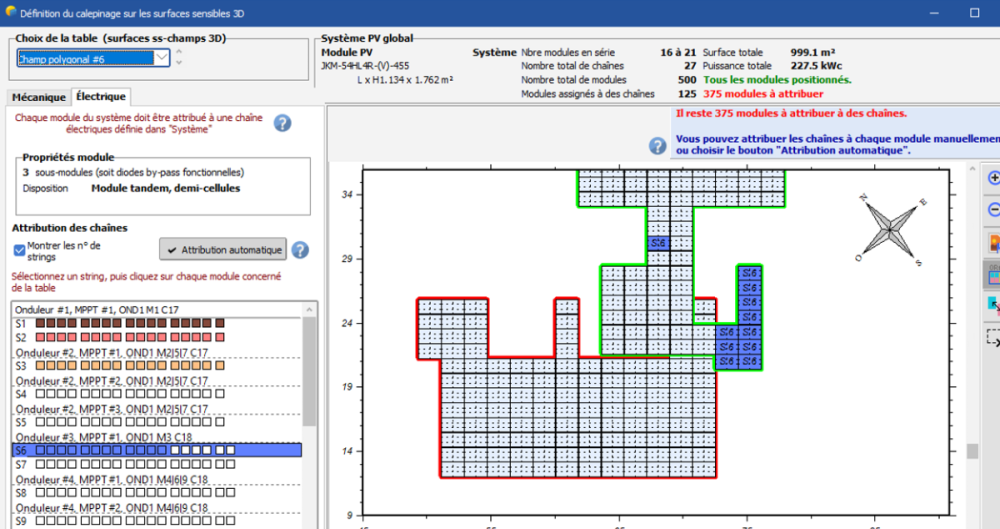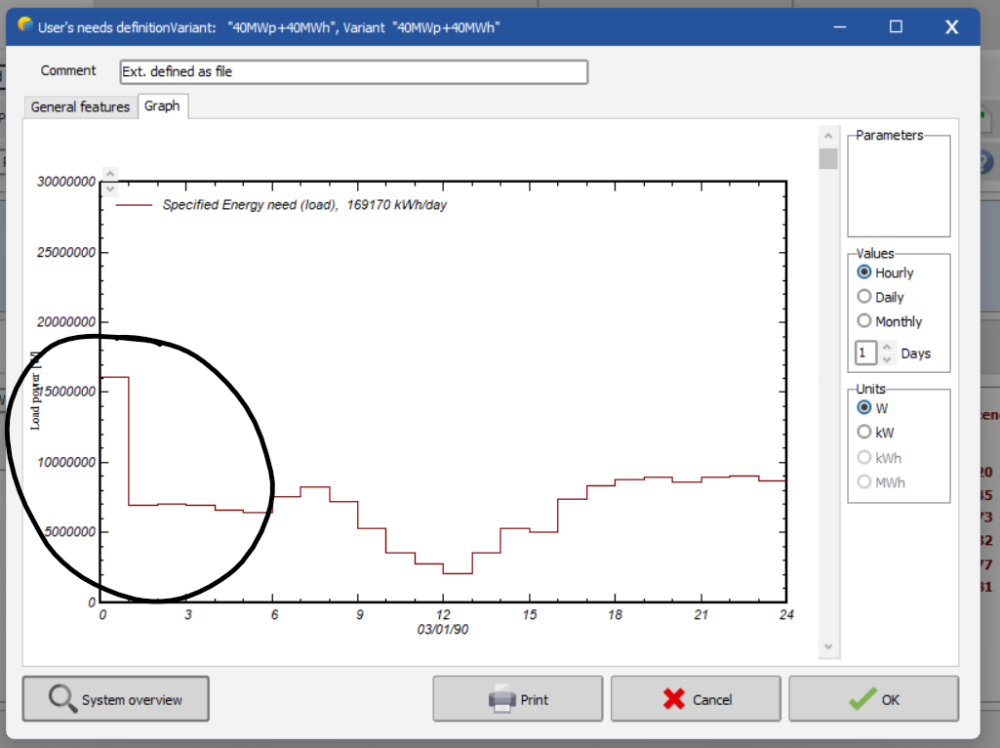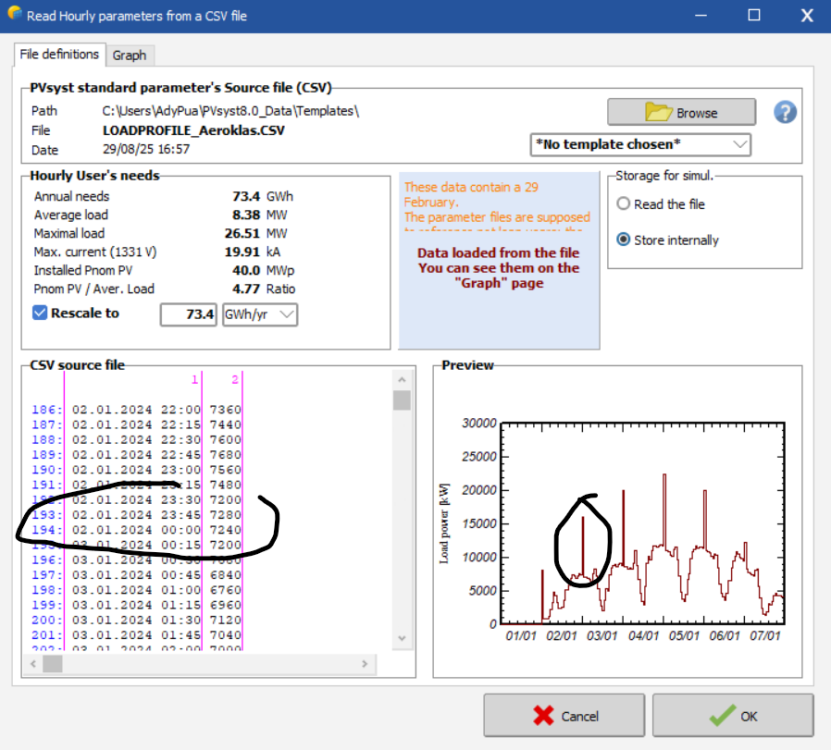All Activity
- Today
-
Hizir Apaydin started following CLI Output CSV file generation failed.
-
Dear Renan, Thank you for reaching out. For "--output-csv-file" and "--report-pdf-file" options, you need to specify the file name with extension, not only the folder: --output-csv-file:"C:\Users\renan\.........\Resultados\Results.csv" --report-pdf-file:"C:\Users\renan\.........\Resultados\Results.pdf" If the problem remains, please export your log files by using the command: PVsystCLI export-logs Once the logs zip file is generated, please send it to support@pvsyst.com Best regards.
-
Compatibility rules between optimizers and inverters are implemented in PVsyst directly based on Huawei's requests. In this case, Huawei requested the maximum connected power to be limited to a certain DC/AC ratio. This is what is displayed in the message box: with only two MPPT input used, the maximum allowed DC/AC ratio is 1. Because you have a total connected STC power of 30.6kW, this configuration is not considered valid for Huawei. Huawei asked us to strictly enforce their rules, so there is no possibility to overstep this one. The only solution is to change your system somehow (configuring more strings, or slightly altering your inverter AC power or modules power so keep the DC/AC ratio below 1). Nb: Mixed orientation are only applied to different strings, not on different modules within a string. Since you can individually assign strings to each MPPT inputs with Huawei, the concept of mixed orientation is redundant and often misleading. In future releases, the mixed orientation option may not be possible anymore with Huawei, and you will have to separate your subarray into two, each with its own orientation.
-
Phuong Nguyen joined the community
-
Renan started following CLI Output CSV file generation failed.
-
I can't generate the .CSV output from the simulation. I've tried several command generation combinations in the CLI command generator, but every time I try, I get the error message "Output CSV file generation failed." I really don't know what else to do and I'm concluding it's a PVsyst CLI bug. The PDF report is generating normally. See a print of the process.
-
Renan joined the community
- Yesterday
-
Hello everyone, I am working with PVsyst simulations and I would like to know how I can evaluate the losses associated with grid voltage variations on the inverter. My understanding is that when the AC voltage deviates from the nominal value, the inverter may increase the current to maintain the power, which could lead to limitations or losses. Is there any specific parameter or report in PVsyst that shows these losses due to operation outside the nominal grid voltage range, or should they be analyzed indirectly through "grid limitation" or another indicator? In addition, is it possible to analyze this effect in graphs or specific reports within the software, and what type of analysis could be obtained to quantify it?
-
WDC started following Huawei optimizers - PNom ratio error
-
Hello, I noticed a error when using Huawei 30/40/50KTL-M3 with MERC-1100W-P optimizers. According to the MERC-1100W-P manual, the maximum power of an optimizer string is 20kWc. In my configuration I have a Huawei 30KTL-M3 with 2 strings of 36 450Wc panels (18kWc per string), which should be accepted by PVSyst but I got this error. How can I overstep this PNom ratio limit ? Thank you in advance, Best regards
-
WDC joined the community
-
Hello, Yes if you are defining the MPPTs you have an interest to use the Auto-equal Pnom option, to avoid overload losses in some sub-arrays while other underperform. If you have multiple orientations, you can use the multi-orientation daily sharing option. Kind regards,
-
dlartin started following Système avec Optimiseur Merc 1300w
-
merci pour votre aide, j'ai pu avancer sur le problème, juste que maintenant, après configuration de la moyenne de l'orientation, le problème persiste.
- Last week
-
Hi Linda, Thanks for the reply! May I ask if its always the case for MPPT sharing, to use Auto-equal. Pnom option? Thanks, Aidenn
-
Markmax6 joined the community
-
Bruno Wittmer started following Calculation of TArray
-
The PV module efficiency is the power generated by the PV module, divided by the power reaching the module in form of light. The generated power is calculated with the single diode model for the given external conditions (irradiance and temperature), while power in form of light is just the irradiance times the surface of the PV module.
- 3 replies
-
- tarray
- simulation
-
(and 1 more)
Tagged with:
-
I don't see what you mean by "some modules are overlapping". For filling your field, you can do that manually by the mouse. But you can possibly use the option "Attribution automatique" (you have many options for doing this), and than correct what seems not suited for you, by exchanging/dragging the string attributions with the mouse.
-
Hello, Indeed, this is not the expected behavior. Since the grid limitation is applied at the Pnom, we have observed that in certain situations—when the MPPTs operate under very different conditions—this may lead to results that do not perform as intended. To analyze your project in more detail, could you please export it as a .zip file and send it to our support team at support@pvsyst.com? We apologize for the inconvenience.
-
nabdulgalil joined the community
-
The answers to your questions are fully explained in the help: https://www.pvsyst.com/help/project-design/array-and-system-losses/ageing-pv-modules-degradation/index.html?h=ageing https://www.pvsyst.com/help/project-design/array-and-system-losses/ageing-pv-modules-degradation/module-performance-degradation.html 1. - ISC dispersion has nothing to do with the datasheets information. Its nature is explained in the help. 2. - You can evaluate the effect of the Current and Voltage degradation weighting by yourself, by excuting several simulations. You will see that this is not very significant. 3. - When you have one only module, it is quite obvious that you don't have any mismatch loss. 4. - In the ageing process, the mismatch between "degraded" modules increases along the time. 5. - This is an input parameter. The global degradation is the sum of the individual PV modules degradation and the increasing mismatch.
-
Hello, when I’m doing the electrical layout, I notice that some modules are overlapping. Screenshot below. Could you tell me if there is a solution, because I can’t create a module string for the upper PV field.
-
Hello Michele, thanks for your answer. Could you specify which calculation method you use for step 5) ? I found several methods but not sure which one is correct. Can I calculate it out of hourly output values? Thanks for your help!
- 3 replies
-
- tarray
- simulation
-
(and 1 more)
Tagged with:
-
JaSc joined the community
-
Bonjour, PVsyst ne permet pas la création de chaine de modules avec des orientations différentes, optimiseurs ou non. Si les deux orientations sont suffisamment proches, vous pouvez utiliser l'option d'orientation moyenne dans la scène 3D. La valeur de l'orientation utilisée pour la transposition sera celle de l'orientation moyenne, mais les ombres seront calculées sur la base de l'orienation réellement définie dans la scène 3D.
-
Dear Nicolas and Laura, Thank you for your post. We appreciate your feedback and your suggestions for improving PVsyst. Accessibility — including considerations for colour blindness and support for visually impaired users — is an important topic we are actively discussing, and we hope to bring improvements in this area in future versions of PVsyst. Regards, Eric
-
I want to check how the Voc of a module changes at different temperatures and irradiance levels. How can I verify this? Although I tried the graphs section and the PV curve, I believe it is showing Vmp values instead. Please suggest how I can check the Voc of a solar PV module under these conditions.
-
Bonjour, Je voudrais savoir comment définir un système PV avec des Optimiseur. le champs global comporte 2 orientations différentes donc nécessites des optimiseur, mais impossible de définir le nombre de panneau avec une orientation différentes. il y a une différence entre le système et la 3D.
-
dlartin joined the community
-
Dear Zahra, If you know the exact global wiring resistance of your system and want a precise result, you can fill in the field "Global wiring resistance". Usually, the value for "Loss fraction at STC" is used when the exact global wiring resistance is unknown and you are just estimating it based on the STC value. For module losses: LID losses: Not applicable for PV modules based on n-dop wafers. You need to know the technology used in your PV module. Otherwise, we don’t have precise information regarding LID losses, since manufacturers don’t usually share this type of data. You can decide to add 1% or 2% depending on your confidence in the PV module. See our help page: https://www.pvsyst.com/help/project-design/array-and-system-losses/lid-loss.html Module Quality: Please read our help page: https://www.pvsyst.com/help/project-design/array-and-system-losses/module-quality-losses.html Module Mismatch Losses: Please also see our help page: https://www.pvsyst.com/help/project-design/array-and-system-losses/array-mismatch-losses/index.html Usually, this is also an approximation, based on your assessment of the PV module quality and the variability between them. Regards,
-
Letan591 joined the community
-

Electrical Mismatch Losses
AlexBackCwbBrazil replied to AlexBackCwbBrazil's topic in Shadings and tracking
Thanks! -

Sudden Load Profile Spikes After Importing File
Linda Thoren replied to Ady's topic in Problems / Bugs
I notice that you have a warning message indicating that your file contains data for the 29th of February. Are you using weather data for this specific year (a leap year) or a generic year ? Try to take out the 29th of February from the dataset. -
Hello, The differences in the databases will be in the global horizontal irradiance, and thus only indirectly on the global incident in collector plane. To calculate the Global incident in the collector plane, the same transposition method can be used for any source of weather data. The difference in direct and diffuse irradiance for instance can have a large impact in the incident in the collector plane. You can read mora about the transposition model in the following help page: https://www.pvsyst.com/help/physical-models-used/irradiation-models/transposition-model.html Indeed, there can be large differences in the weather data and it is difficult to evaluate which one is the most accurate at a specific site. We have done some comparisons that you find in the following help page: https://www.pvsyst.com/help/meteo-database/import-meteo-data/data-source-comparison.html?h=weather+data
-



